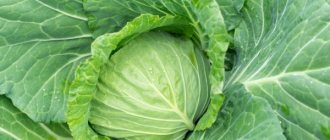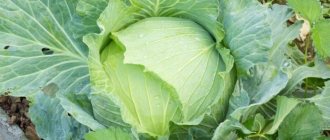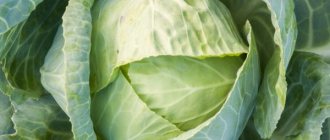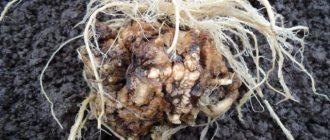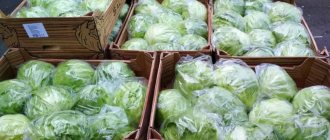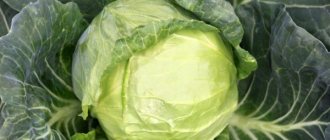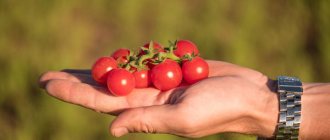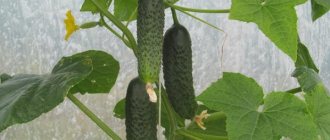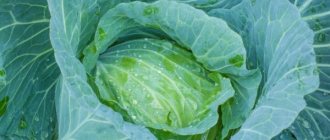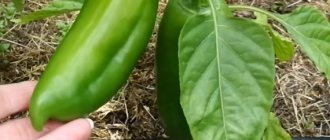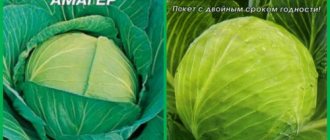Vegetable growing » Cabbage
0
1163
Article rating
Kira Stoletova
Excellent transportability, impressive head size, stable yield and ease of processing - these are the properties of Krautkaiser f1 cabbage. This European hybrid vegetable is adapted to growing in temperate climates.
Characteristics of Krautkaiser cabbage variety
Krautkaiser cabbage variety (F1)
Most of the cabbage that is used for various processing and stored is, as a rule, mid-season varieties. These include Krautkaiser, which belongs to the Dutch selection. The ambition of the hybrid is evidenced by the name, which is translated from German as “Cabbage Monarch.” It was included in the State Register of Breeding Achievements of Russia a long time ago, in 1993. Applicant and originator Bejo Zaden BV The variety received permission for cultivation in most regions of Russia: Northwestern, Northern, Central, Lower Volga, Volga-Vyatka, West Siberian, East Siberian, Ural and Far Eastern. The State Register recommends it for fresh use and for pickling. Our hero belongs to the hybrids and is labeled F1.
Mid-season varieties
Mid-season varieties of white cabbage are most often grown by summer residents and villagers, since they are best suited for pickling - the favorite method of preparing cabbage in Russia.
Distinctive features:
- the growing season is 130-170 days, they begin to ripen when the early varieties are already leaving;
- fork density is average,
- the leaves are juicy, white inside, contain a lot of sugars;
- high productivity,
- best for pickling and canning,
- They are not stored for long, maximum until the New Year.
Universal mid-season varieties
Slava 1305
For almost 80 years, this variety has remained the most beloved among the people, despite the huge number of new products. Sweet and juicy Slava leaves are very tasty fresh and are great for pickling. The forks gain weight by 2.4-4.5 kg. They are not stored for long, 2 months.
Belorusskaya 455
Another popular old variety. Very good for fermentation and can be stored fresh until the New Year. The forks are dense, weighing 1.3-4.1 kg, and do not crack.
The most productive mid-season cabbage of domestic selection. Ripens in August, stored until February. Tasty both pickled and fresh. Dense forks weighing 3.0-3.5 kg do not crack. The average yield is 7.5-11.9 kg/m.
Rinda F1
Mid-season Dutch hybrid from Monsanto. The forks are dense, with a pleasant taste, and are stored on the root for a long time. The inner leaves are white with a yellow tint. It is unpretentious to growing conditions and can be re-sowed in summer. Delicious both fresh and canned. Stored until the New Year. Head weight is 3.3-3.6 kg, very productive, about 9 kg/m.
Mid-late variety of 1960, selected by VNIISSOK. Disease-resistant, stored for 6 months. The heads of cabbage are very dense, weighing 2.6-4.4 kg, and do not crack. From one sq. m you can collect up to 10 kg of cabbage. Tasty, good for pickling.
Megaton F1
A mid-late, very productive hybrid from the Dutch company Bejo Zaden. Cold-hardy, resistant to clubroot, gray rot, fusarium wilt. Can be planted more densely than other varieties. The heads of cabbage grow up to 10 kg, are tasty, and very good when pickled. Stored until January. Suitable for growing for sale in large farms.
Mid-season varieties for the North, Urals and Siberia
Cabbage is a cold-resistant plant and can grow normally at temperatures of 10-15 degrees. Almost all universal mid-season varieties grow well in regions with short, cool summers. But there are several bred specifically for the North, the Urals and Siberia.
Siberian 60
Mid-season, ripens a week later than Belarusian. Tolerates cold weather well. The forks are moderately dense, weighing 2.1-4.3 kg, and do not crack. Good both fresh and pickled. Can be stored for up to 4 months. Productivity 3.4-8.6 kg/m.
Middle late, zoned across Eastern and Western Siberia. Rarely gets sick. The forks are dense, weighing 2.3-4.5 kg, do not crack, and have good taste. Florin is grown for winter storage and fresh consumption.
Description
The plant is powerful, non-lodging, with a raised leaf rosette. The leaf is medium in size, obovate, slightly concave. The edge of the leaf blade is smooth, the venation is pinnate, the surface is slightly wrinkled. The leaf color is blue-green, the wax coating is medium or very intense. The heads of cabbage are leveled, flat-round in shape, partially covered, dense (the State Register rates the density as excellent), juicy, whitish when cut, with an excellent internal structure. The inner stump is of medium length, the outer one is short. The taste is good. The originator declares the weight of the finished head of cabbage to be from 3.0 to 6.5 kg, the State Register - from 3.2 to 4.8 kg. The rapid growth of the vegetable allows cabbage weighing about 2.5 kg to be harvested within 100 days after germination.
Characteristics
- In terms of ripening time, Krautkaiser belongs to the mid-late varieties. From the appearance of full shoots to the start of harvesting, it can take from 127 to 161 days. This variation is due to weather conditions, because the geography of crop cultivation is wide;
- The variety produces a harvest quite well. According to the State Register, the marketable yield is 574 - 1055 c/ha. The hybrid pleased with its maximum indicator in the Krasnoyarsk Territory, where it was possible to collect 1284 c/ha;
- the plant is valued for its excellent adaptability to any climatic conditions and tolerates cold weather and heat equally well;
- the hybrid shows good resistance to cracking in field conditions;
- immunity is quite good. There is resistance to gray and white rot, vascular and mucous bacteriosis. However, the plant can be severely affected by clubroot;
- transportability is excellent;
- keeping quality is good; if storage standards are observed, the vegetable can retain freshness and taste for up to 4 months;
- method of use is universal. Cabbage is consumed in its natural form and is suitable for various processing. But first of all, our hero is ideal for fermentation.
Agricultural technology
The variety can be grown by seedlings or without seedlings. To achieve high yields and grow large heads of cabbage, experienced agronomists recommend maintaining a planting density of up to 40 thousand units per 1 hectare. A special feature of the hybrid is its high adaptability to any soil. During the care process, cabbage requires preventative treatments.
Krautkaiser is recognized by many as one of the best among mid-late hybrids. An unpretentious plant that adapts to various types of soil and any climatic conditions, and at the same time gives an excellent harvest - the dream of any gardener. In addition, the variety is suitable for storage and is excellent for pickling. His immunity is high, but our hero copes poorly with one disease, clubroot.
Agricultural technology for growing and caring for cabbage
Krautkaiser white cabbage requires heat, so it is preferable to use the method of growing the crop with seedlings.
Important! Growing a hybrid without seedlings is possible only in regions with a warm climate.
Preparing and planting seedlings
Krautkaiser cabbage seeds have a high germination rate, but still require preliminary preparation before planting.
The preparation procedure is carried out in several stages:
- 1. The seed is placed in a piece of gauze and dipped in hot water (no more than +50 °C) for ¼ hour.
- 2. Cool the seeds in water at room temperature.
- 3. Soak the grains in a growth activator for ½ day.
Preparing cabbage seeds for planting
The soil for planting is also pre-disinfected. To do this, place it for ½ hour in an oven heated to 190 °C.
Description of the cabbage variety Krautkaiser F1
Krautkaiser F1 cabbage is a mid-season hybrid of Dutch selection. This is a relatively old variety, which was included in the State Register of the Russian Federation in 1993. The development of this vegetable was carried out by the company Bejo Zaden BV, known to many farmers. It is recommended to grow cabbage in the following regions of our country:
- North-West.
- Severny.
- Central.
- Nizhnevolzhsky.
- Volga-Vyatka.
- West Siberian.
- East Siberian.
- Uralsk.
- Far Eastern.
What kind of cabbage is this
Krautkaiser is a hybrid of white cabbage, characterized by its ability to adapt to different climatic conditions and any type of soil.
The harvest is harvested in September by digging up the cabbage with a shovel. After this, the heads of cabbage, which have no damage or signs of disease, are dried under a canopy, wrapped in cling film, placed in wooden or plastic boxes and placed in a well-ventilated room with a temperature of 0...+3°C and an air humidity of 80-90%. Under such conditions, the vegetable is stored for 4-7 months.
History of origin and distribution
The Krautkaiser hybrid was bred in Holland by breeders of the agricultural company Bejo Zaden BV
Included in the state register of Russia in 1993 with permission for cultivation in the Northern, Northwestern, Central, Volga-Vyatka, Lower Volga, Ural, West Siberian, Far Eastern and East Siberian regions.
Description Krautkaiser F1
Krautkaiser F1 plant is powerful, raised rosette type. The leaf is small, obovate. The edge of the leaf is without waviness, the structure has slight wrinkles.
The color of the leaf is blue-green, it is covered with a medium-intensive (or heavily) waxy coating.
The heads of cabbage are leveled, flat-round. The structure of the “heads” is quite dense. The vegetable itself is very juicy, white in the cut, green on the outside.
The outer stump is very short, and the inner one is of medium length. The vegetable is rated as very tasty.
On average, the weight of a technically mature head of cabbage reaches 3-6 kg (according to the originator), however, experimental tests show that the actual weight of the Krautkaiser F1 “head” rarely exceeds 4.8 kg.
Krautkaiser F1 is a mid-season hybrid. From the moment of germination to the technical maturity of the crop, it takes from 127 to 160 days. This huge variation is due to different climatic conditions for growing this vegetable.
Krautkaiser F1 can be safely classified as a high-yielding variety, since if you follow all the rules, you can easily get from 57 to 105 tons of high-quality cabbage from 1 hectare of plantings. As for the peak yield, it was recorded in the Krasnoyarsk Territory, where farmers managed to collect an unimaginable 128 tons per hectare.
Advantages and disadvantages of the variety
Despite the fact that Krautkaiser F1 was unable to break through the chain of very popular varieties, it still has its fans who appreciate the Dutch hybrid due to a number of its advantages. These, in particular, include the following:
- The hybrid adapts perfectly to different climatic conditions. Heads of cabbage equally tolerate both low and high temperatures.
- The heads of cabbage are resistant to cracking.
- The hybrid has strong immunity. The culture very rarely suffers from diseases such as gray rot, vascular and mucous bacteriosis.
- Due to the high density of heads of cabbage, they are easily transported over long distances without losing their excellent commercial qualities.
- This is a versatile vegetable. Cabbage can be eaten fresh, added to salads, borscht, and also processed, in particular, fermented.
Does a hybrid have any disadvantages? Yes, there are not very many of them, but it’s worth mentioning:
- First of all, this is susceptibility to a disease such as clubroot.
- Also, cabbage is not stored long enough, up to 4 months, and only if all storage rules are followed. Otherwise, this period is significantly reduced.
Advantages and disadvantages
- Vegetable growers cultivating the Krautkaiser hybrid note a number of its significant advantages compared to other cabbage varieties:
- large fruit;
- unpretentiousness to soils;
- good adaptation to different weather conditions;
- high yield rates;
- excellent presentation of heads of cabbage;
- versatility in the use of fruits;
- good transportability even over long distances;
- excellent keeping quality of fruits;
- long shelf life of products, from 4 to 7 months.
- Meanwhile, the hybrid is not without some disadvantages:
- average frost resistance;
- low resistance to some diseases;
- susceptible to clubroot;
- requirement for regular hydration.
Cultivation care
Cabbage is a rather capricious crop and is more difficult to grow than many other agricultural plants. The main problem is its love of water, which at the same time results in intolerance to stagnant water.
But generally speaking, having grown cabbage several times, even an inexperienced gardener will understand that it is quite simple. You just need to follow a number of rules:
- Water on time.
- Fertilize several times.
- Periodically loosen the soil.
Watering
As noted earlier, cabbage needs a lot of water. Therefore, you should follow the watering regime. It is best to water cabbage in the early morning or evening, when there is no sun and there is no risk of burning the leaves of the plant.
You shouldn’t water the cabbage very often, as it will get used to it and won’t deepen its roots (water will be available all the time). The ideal frequency is once every 5 days (when it is very hot, more often, approximately once every 3 days).
After watering, the soil around the plant is loosened. The first loosening should not be deeper than 4-5 cm, so as not to damage the cabbage root system. Subsequent loosening is carried out to a depth of 7-8 cm.
Since Krautkaiser F1 has a fairly short external stump, the plant can be hilled only once per growing season.
Growing technology
When planting Krautkaiser cabbage, it is necessary to correctly select and prepare the place and planting material, observe the sowing dates and provide the crop with proper care.
Optimal conditions
Despite his unpretentiousness in soil composition, Krautkaiser prefers nutritious, light, loose soil with a medium or neutral acidity level.
The best option is loam or black soil. In the fall, the area is loosened, dug up with a shovel, and fed with mineral fertilizers, humus or compost.
The planting site should be sunny, open, protected from drafts and cold winds. The best predecessors are legumes, cucumbers and potatoes.
Important! You cannot plant cabbage in lowlands - stagnant moisture leads to rotting of the root system.
Before sowing, the seeds are wrapped in gauze for 20-25 minutes. lowered into a warm place (+45…+50°C), and then for 2-3 minutes. into cold water. After this, the planting material is soaked for 12 hours in a solution of a growth stimulator (Kornevin, Epin), after swelling, it is again wrapped in gauze and put in the refrigerator overnight. For 2-3 days, the seeds are kept at room temperature during the day and placed in the cold at night.
To grow seedlings, use a substrate consisting of equal parts of humus and turf soil with the addition of wood ash. To disinfect it, it is calcined in advance for half an hour in the oven at a temperature of +180°C or spilled with a pale pink solution of potassium permanganate.
Landing dates and rules
Seeds for seedlings are sown in mid-April . The prepared substrate is poured into containers with a layer of 7-8 cm, depressions of 1-1.5 cm are made on the surface, seeds are placed in them, covered with soil on top and watered generously with a spray bottle.
Cover the container with polyethylene and put it in a bright place at a temperature of +18…+23°C. After 5-7 days, when shoots appear, the shelter is removed and for 13-15 hours the seedlings are transferred to a cooler place with a temperature of +15...+19°C.
When two full-fledged leaves are formed on the seedlings, the seedlings are planted, burying the cotyledon leaves into the soil.
15 days before transplanting seedlings into the ground, they begin to harden them. To do this, containers with seedlings are taken out onto the street or balcony every day, first for 5-6 hours, gradually increasing this time.
30-35 days after sowing the seeds, the seedlings are planted in open ground. Depending on the climate of the region, this time falls at the beginning, middle or end of May.
Landing rules:
- Form rows on the prepared area at a distance of 50-60 cm from each other.
- Dig planting holes in them every 40-50 cm.
- Water them generously with settled warm (+18…+20°C) water.
- Remove the seedlings from the container along with a lump of earth and place them in the holes.
- Cover the plants with nutritious soil and water generously.
The optimal planting density of Krautkaiser is 30-35 thousand per 1 hectare.
Further care
Within 2-3 weeks after transplanting the seedlings into the ground, it is watered 2-3 times a week. Then watering is carried out once every five days, in case of hot and dry weather - every three days.
The soil must be constantly moistened by at least 80% - this is necessary for the formation of large heads of cabbage. During the period of maturation of the heads, watering is stopped to avoid their cracking.
The soil is loosened weekly. For the first time to a depth of 4-5 cm, then 7-8 cm. This improves access of oxygen and moisture to the roots, enriches the soil with nutrients, activates the growth of greenery and avoids the formation of a dry crust on the soil surface.
Cabbage is hilled twice a season - after the formation of small heads and 2-3 weeks after that. The procedure is carried out after rain or watering, raking the soil up to the trunk to the level of the first full-fledged leaves. The soil between the rows is sprinkled with wood ash.
Reference. Krautkaiser is able to suppress the growth of weeds, which reduces the need for weeding to a minimum.
Fertilizers are applied at least twice per season:
- 15 days after transplanting the seedlings - a solution of ammonium nitrate (10 g per 10 liters of water);
- period of setting heads - 8 g of potassium sulfate, 5 g of double superphosphate and 4 g of urea, diluted in 10 liters of water.
Possible problems, diseases, pests
Cabbage can be affected by:
- Clubroot is a fungal disease that affects the roots of plants causing growths to appear on them;
- peronosporosis (downy mildew) - white spots appear on the underside of cabbage leaves, which over time spread over the entire surface of the leaf blades.
To prevent diseases, the soil on the site is limed, regularly loosened and weeded, the level of soil moisture is monitored and treated with fungicidal preparations - “Fitosporin”, “Oxychom”, “Abiga-Peak”.
Pests dangerous to Krautkaiser are flea beetles, aphids and cabbage flies. To get rid of insects, plantings are treated with ash decoction and insecticides, for example, “Bazudin”, “Iskra-M”, “Senpai”, “Fufanon”, “Inta-Vir”.
Reviews from gardeners
Vladimir Ivanovich, Odessa, 54 years old.
Based on the results of last year, the Krautkaiser F1 hybrid performed best for me. The cabbage is really very good. And the harvest was good, and I tried fermenting, and it turned out great, although previously I fermented mostly late varieties. This year we decided to plant more of this cabbage and use it for pickling. As for the head of cabbage, it is quite large, we had at least 5 kg, there were some heads of 7 kg each. Of the shortcomings, about the strong one. It takes up a lot of space in the garden.
Valentina Yuryevna, Kirov, 43 years old.
I always grow the following varieties of cabbage for pickling: Krautkaiser, Atria and Krautman. All good, tasty, juicy. Krautman's real drawback is that the root system is located very close to the surface and always leans to one side. There are no such problems with Atria and Krautkaiser. I have never stored this cabbage, so I can’t say how long it can be stored in the cellar. The seed packets say 4 months, so I'm thinking somewhere in that range. And so I grow it purely for pickling. No one in the family particularly likes raw cabbage.
History of selection of Krautkaiser cabbage variety
White cabbage Krautkaiser F1 was bred in Holland agro. Entered into the State Register of Russia in 1993. Suitable for cultivation in areas with temperate climates, namely in:
- Ural;
- Volgo-Vyatka;
- West Siberian;
- East Siberian regions;
- Lower Volga zone.
Suitable for use in salads and for pickling.
Description of appearance and characteristics
Krautkaiser is a cabbage hybrid with a medium-late growing season. From the appearance of sprouts to harvest, an average of 130 - 160 days pass. The timing of the growing season directly depends on climatic zoning.
Additional Information! Sometimes Krautkaiser is classified as an early ripening crop. Already 3.5 months after germination, cabbage forks grow up to 2.5 kg and can be stored in the cellar for long-term storage.
The botanical description of Krautkaiser cabbage includes the following parameters:
- The rosette of leaves is powerful, raised above the ground.
- The leaf blades are medium in size, wavy along the edges, with a waxy coating.
- Leaf color is blue-green.
- The forks are round, smooth, dense, and white when cut.
The main characteristic of Krautkaiser cabbage is its high yield. The weight of one head of cabbage ranges from 3 to 6 kg, that is, approximately 6 to 13 kg of fruit are harvested from a square meter of garden bed.
The taste of the culture is high. Cabbage leaves are juicy, with a pleasant sweetish note.
This is interesting! Inexperienced gardeners often get confused about the names, calling this variety of cabbage “cruiser”.
Characteristics of the variety
The variety is early ripening. The characteristics of Krautkaiser cabbage indicate its ability to quickly adapt to any type of soil and weather conditions. The period of technical ripening of the variety is about 110-120 days from the date of appearance of the first shoots (a difference is possible depending on the climatic conditions of the region). However, already 100 days after germination, the heads of cabbage gain a weight of 2.5 kg and are suitable for collection for the purpose of long-term storage.
The variety has a well-developed leaf apparatus. Krautkaiser f1 is able to suppress weeds, which significantly reduces weeding requirements.
The preferred planting density of the variety is 30-35 thousand per 1 hectare. The hybrid is unpretentious and suitable for processing using mechanical methods.
Description of the head of cabbage
The heads of vegetable are round in shape, fairly even in shape and caliber. Their average weight after reaching technical ripeness is about 3-4 kg.
The color is light green, with a characteristic slight shine. The internal structure is developed: the forks are dense, evenly filled, without voids. The taste is sweetish, juicy.
Application of the vegetable
The description of Krautkaiser cabbage indicates that the hybrid is suitable for long-term storage (up to 7 months or more) and is resistant to rotting. In this case, vegetables should be collected in dry weather, undamaged heads should be sorted and dried for 1-2 days before placing them in permanent storage.
The vegetable is transportable, transportation over long distances is possible without loss of product quality.
This vegetable is consumed fresh, as well as in various hot dishes and pickles.
The vegetable contains a large amount of vitamin C.
Advantages and disadvantages
Hybrid Krautkaiser F1 has a number of positive properties:
- tolerates heat and cold well;
- not prone to cracking;
- has immunity to gray and white types of rot, as well as bacteriosis;
- transports well;
- has good shelf life (about 4 months).
Gardeners include the following disadvantages of the crop:
- weak immunity to clubroot;
- the need for regular hydration;
- average level of frost resistance.
Note! A powerful seed bush grows from a head of cabbage planted in spring. However, it will not be possible to collect high-quality seeds from it.
Pest and disease control
Despite the high immunity to many cruciferous diseases, Krautkaiser cabbage is susceptible to:
- clubroot;
- downy mildew (peronosporosis);
- viral infections.
Among the pests that pose a danger to the hybrid are cruciferous flea beetles, aphids, and caterpillars.
To prevent infection, the soil on the site is periodically loosened, its moisture level is controlled, and the crop is treated with fungicides and/or insecticides.
Diseases and pests
Hybrid Krautkaiser has varying degrees of disease resistance. For example, it is not affected by point necrosis and fusarium. But you can get sick with rot (white and gray), clubroot, downy mildew or bacteriosis. This happens when the rules of agricultural technology are violated.
Clubroot is characterized by growths on the roots.
Infection can be prevented by liming the soil
Downy mildew affects not only the leaves, but also other parts of Krautkaiser cabbage.
Bacteriosis makes cabbage unsuitable for use
The most common pests are flea beetles, cabbage flies and aphids.
Pests have to be fought with insecticides
